English Publications
Can human violence be controlled?
Can human violence be controlled?
A Montessori perspective
Silvana Q. Montanaro
As early as 1932, in a speech delivered in Geneva on the subject of peace, Maria Montessori wondered how society could acclaim at one and the same time both the scientist who discovers a microbe or a live-saving serum, and the scientist who discovers weapons capable of destroying the life of a whole population, perhaps of all humanity.
“Obviously,” she said, “this dangerous duality of the collective personality must be explained in an unedited chapter of human psychology as some untamed force that threatens humanity.”
The more we progress in self-awareness through the study of human sciences, such as psychoanalysis and psychology, the more we are terrified by our capacity for violence and by the effects of this perverse force. By analyzing our-selves, we have reached the understanding that violence is subtly hidden in many of our daily actions under various labels, it starts to act from the moment of birth, if not even before birth.
Violence can be defined as an excessive force exercised to the detriment of others. Violence is action, and in this sense is different from aggressiveness, which can be considered as a tendency to exercise constriction and damage on another.
The problem of aggressiveness that evolves into violence has always been a subject of human interest. Human sciences have always tried to understand the reasons for behavior that is so damaging. Some believe the potential for violence is inherent in human nature itself. Others have always considered violence as a reaction to unsatisfactory, if not cruel, living conditions –often perpetrated by human beings against their neighbors. This concept, which divides the world into good and evil, leaves unsolved the problem of how so called “evil people” develop.
There are important genetic and hormonal factors in the formation of aggression. But the decisive factor in determining the future of aggressiveness is experience, which begins in the womb (Laing: the stone womb) and continues in the kind of care the child receives and in the possibility of early socializing.
The old psychoanalytic interpretation of aggression as negative, has given way to the assumption of “the existence of a primary and individual aggressive instinct, at the service of life –not death.” This instinctual activity provides the developing child with energies that can be translated into movement.
Though movement, the child comes into contact with the environment and gains control over his body. This autonomy is muscular, but it is also related to mental autonomy, which transforms the human being from a passive into an active person capable of taking initiatives.
The desire for movement must be recognized as neutral aggression in evolution, and as such should be respected by the adult, who must not only accept this movement but also –and here lies the fundamental role of education- channel it towards concrete and intelligent activity.
When the child structures a healthy aggression, he learns to manage on his own (“Help me do it by myself!”), to act autonomously and to have adequate relationships with people and with things, then the child learns to love.
Sometimes adults (especially mothers, who interact most with their children’s aggressions) consider this continual desire for mobility as being wrong and so they punish children with hostility. As a result, children come to feel that they have no right to move. Since they are incapable of distinguishing a part from the whole, they end up feeling that any initiative is bad and any action is a form of rebellion. “To do something” becomes synonymous with “to act against someone,” that is to hate. There arises (through negative identification with parent) a harmful principles: “When you want something from someone, you must use violence against them.” Thus aggressiveness is transformed into hostile aggression.
But where aggression can become constructive, it is transformed into activity and spirit of initiative, in harmony (rather than conflict) with self and surroundings. The two processes may be summarized as follows:
If we manage to have children learn to be aggressive in a productive way, they will become reasonable and free human beings, the sort of persons that every nation says it would like to have as citizens. But mostly, people, as they grow up, become incapable of channeling their aggressive energies productively. Even work in scientific, literary, artistic and sporting fields is often used for the purpose of dominating others.
Recent experiments have clearly shown that the more aggressiveness is hostile, the less it is productive: the best qualities of a person are wasted, to his own detriment. This force of aggression, so precious in life, may turn towards love or hate, towards production or towards hostility. In the latter case, it may become destructive aggressiveness leading to the most radical ferocity. In every age of human history, we find examples of such ferocity. Each group denies the evil (aggressiveness) in themselves and sees it only in others (schizoid alienation), and in these circumstances humanity becomes threatened with extermination.
Maria Montessori, in her book Education and Peace, clearly recognized the root of the degradation of the activity instinct (which we have called neutral aggression). She recognized in the child, the future adult, the need for self-fulfillment through freedom of movement for the achievement of specific purposes. The body must be an instrument at the service of the mind, it must serve to transform and adapt the environment in which one lives to meet one’s real needs. Children must be provided with the necessary means, with materials allowing them freedom of action –as they are, for example, in the Children’s Houses.
In such an environment, children achieve a harmonious social life at a very early age and manifest characteristics unknown to the adult. “What is delightful for a human being,” said Maria Montessori, “is not to possess things, but to be able to use the” –to use them as a means to improve oneself and one’s environment.
It is in the proper use of things that a love relationship develops between the child and his surrounding environment of people and things. All work leads necessarily to association, because no one could work long in isolation. The possibility of acting on things uplifts the child. If he is prevented from action, a morbid attachment develops toward people and things. Instead of mastering them, he becomes enslaved by them, interaction is replaced by fighting and possessiveness.
We have seen that there are two courses between which initial aggression can flow:
- a) That of a positive evolution, which allows the child to act in a human way to improve himself and make himself united with the environment in a love relationship. This is a normal being, defined by Freud as capable of working and loving.
- b) That of a negative evolution, in which the child is prevented from acting and becomes a hostile being, fomenting hatred and aggression towards others and regression in himself.
The analysis of the phenomenon of aggression that Maria Montessori made so many years ago is still valid. I continued to be amazed at how easy and possible it is, in the right environment, to direct the vital forces of the child towards his personal development, giving at the same time joy and satisfaction, building a social being capable of collaboration.
LEARNING THROUGH FREEDOM IN A MONTESSORI CLASS
The reason students shouldn’t sit in class
Laura Flores Shaw
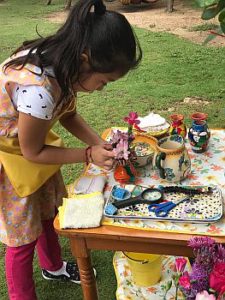 A recent article in the New York Times discussed why children should be given opportunities for movement during class. I wholeheartedly agree with this proposition — but not for the reasons stated.
A recent article in the New York Times discussed why children should be given opportunities for movement during class. I wholeheartedly agree with this proposition — but not for the reasons stated.
Movement is far more important than a means to enable children to attentively sit for long periods of time.
Educators (and parents) need to understand that the need for movement goes beyond the value of aerobic exercise as cognitive and motor development are intertwined. Children with learning disabilities often have poor gross motor skills. And children with developmental coordination disorder and undiagnosed motor difficulties (including manual dexterity) score lower on measures of executive functioning skills (working memory, inhibition, task switching, planning, and verbal fluency) — skills necessary not only for academic achievement but also for life.
This relationship between movement and higher-level thinking, or executive functions, makes sense given what we now know about how the brain operates: subcortical brain regions involved in movement (the basal ganglia and cerebellum) communicate reciprocally with higher, cortical regions. This view of brain functioning is different from the traditional paradigm in which the top of the brain (cortical) dominated the rest of the brain (subcortical).
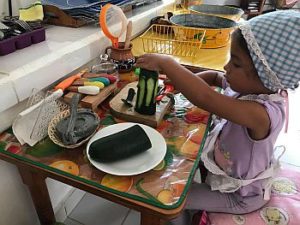 For years it was assumed that thought only occurs within the higher, cortical regions, particularly the prefrontal cortex. Thus, the prefrontal cortex was tasked to direct the rest of the brain — especially those primitive subcortical regions. Essentially, thought, even within neuroscience, was disconnected from the movement of the body. But what the data now show is that those cortical regions are simply part of the circuitry for higher-level thinking, and that circuitry includes the subcortical regions. As Stanford neurologist Josef Parvizi states, the data suggest that “the so-called ‘higher’ functions of the brain might in fact depend on signals from subcortical to cortical structures rather than the other way around”. Neuroscience now recognizes that thought is not disembodied as movement and cognition are closely intertwined.
For years it was assumed that thought only occurs within the higher, cortical regions, particularly the prefrontal cortex. Thus, the prefrontal cortex was tasked to direct the rest of the brain — especially those primitive subcortical regions. Essentially, thought, even within neuroscience, was disconnected from the movement of the body. But what the data now show is that those cortical regions are simply part of the circuitry for higher-level thinking, and that circuitry includes the subcortical regions. As Stanford neurologist Josef Parvizi states, the data suggest that “the so-called ‘higher’ functions of the brain might in fact depend on signals from subcortical to cortical structures rather than the other way around”. Neuroscience now recognizes that thought is not disembodied as movement and cognition are closely intertwined.
This current understanding of how the brain operates is important for educators to know for two reasons: 1) because children are not born with well-developed motor systems, and 2) because some of the subcortical regions (particularly the cerebellum) continue to develop during adolescence just as the prefrontal cortex does. For these two reasons, educators — who should be designing school from a developmental rather than efficiency perspective — need to create learning environments in which children of all ages have constant opportunities to engage in a wide variety of gross and fine motor movements throughout the day. Doing so not only builds the circuits for executive functioning, but also gives students a large repertoire of mastered automatic movements they can perform without thinking, freeing up their attention for more creative thinking and problem-solving. After all, it’s difficult to create an award-winning poem or plan out your steps for your research project if your attention is focused on the actual movements of writing (or even typing).
Thankfully, there is one educator who understood the interrelationship of movement and cognition (though she wasn’t aware of the circuitry described above). Maria Montessori created classrooms that are essentially motor (and sensory) training grounds. She said:
From birth through adolescence, Montessori students of all ages are practicing and perfecting a huge variety of movements while learning content knowledge in mathematics, history, English, science, arts, etc. Movement in a Montessori environment is an integrated part of the method is highly complex system. It is not used in order to help children learn as they sit. It’s how the children learn.
Maybe it’s how they should learn in conventional schools, too.
Parent’s work: the basis of our Community Center
It is known as “Community Social Work” to the form of intervention with the community where one works to try to satisfy basic and personal needs with the participation and help of individuals from the same community. This implies the group approach to the solution of a problem, the increase of knowledge and understanding of the needs of the community and the type of precise help so that they can be satisfied using the resources of the same community.
In a basic sense, the concept of community are all forms of relationship that are characterized by a high degree of personal intimacy, emotional depth, moral commitment, social cohesion and continuity over time. Have a common cause founded on the family. Hence, a group of people who live in the same place, with common ties.
In Otoch Paal, the common bond is children and families come to the Community Center to get an education based on the Montessori pedagogy where the Montessori principles are carried out following the indications AMI, dictated according to the teachings of Dr. Maria Montessori
A quality education that could cost a lot of money and get out of the budget of families in the region, however, by joining forces, all contribute the work they can offer to support the maintenance of the school and thus, continue offering their children a worthy space in which they can develop.
Families that can provide monthly fees help to support the needs of the teaching staff, payments of services, etc., while Montessori Pedagogical Training provides continuous pedagogical training to the Guides and Assistants so that they have all the knowledge to present the Development Materials Montessori to children.
This is a way of working in which everyone benefits since a community in which children can have a better education is ensuring a prosperous future.
Mexican traditions, sharing the joy
As every year, the children of Otoch Paal shared their art and love for the Mexican traditions with the guests who enjoyed the Christmas “Posada”. The love for the traditions and the pride of the roots of the place where they live in, are manifested in their dances, in their songs and in each of the cheerful little faces of the children. When seeing among the guests their parents, relatives and friends, they are proud of their work and eager to continue working to obtain the personal gratification of knowing that, what is being done with such love, is well done and appreciated by all.
On this occasion, the party had a beautiful touch of friendship, as the children of the Montessori Schools of Cancun and Montessori Playa del Carmen prepared gifts for their companions of Otoch Paal. The exchange of hugs and smiles was the most beautiful highlight of the night.
As María Montessori says in her book The Absorbent Mind: “Social integration takes place when the individual identifies with the group to which he belongs, in schools the development of this feeling of integration of the individual in society, should be cultivated because it is precisely what is needed everywhere, and this lack is what leads society to bankruptcy and ruin”.
When children can live in a society that shares with love, that lives their traditions with pleasure, that participates in the everyday life in a harmonious way and transmit joy and peace is the best gift we can give to those of us in charge.
At Otoch Paal, we deeply appreciate the gesture of generosity that the families of the Montessori Schools of Cancun and Montessori Playa del Carmen had with us.
We wish everyone to spend a holiday season filled with love and that love be with them throughout the year 2018 and for many more years.
10 years celebrating Peace in Otoch Paal
Pretentious word … peace … Longing …
We all implore it and yet we all deny it, and at some point in our lives, not only ignore it but humble our essence to the selfishness of our whims. Are these words rude? Maybe. But reading them make us have a moment of reflection to make a pause if we feel the absence of the subtle presence of peace in our lives.
Mankind always acclaims who, in one way or another, expressed the desire of peace, transforming it into actions that transcend. Maria Montessori lived difficult times and one of her deepest desires was that children could grow up in an environment that would allow them to develop their lives free from egoism, whims, or arrogance created by those seeking to excel through the power.
For 10 years Otoch Paal has opened its doors with the firm intention of seeking spaces that promote a harmonious environment in which the essence of each one of the children can manifest. When we get in the classrooms, the gentle caress of the harmonious murmur with which children express their creativity is perceived immediately. During times of recreation, children exploit the generous sharing energy that drives them to do. It is a constant self-construction of human beings in peaceful environments.
The “Table of Peace” is, in every classroom, a space high frequently visited by children. The experiences that arise from it are tracing deep furrows that mark the personality of the child making them reflective, good listeners, respectful children, who are able to express their own point of view and who can reach agreements, tolerating the differences and proposing solutions.
Celebrating 10 years of Education for Peace in Otoch Paal, is to celebrate life, it means shearing the essence of Montessori’s thought the roots. Let’s open our hearts and let’s live peaceful moments in our daily lives. Let Montessori be more than the name of school for children, let’s make it a philosophy of life in our community.
The greatest love: separation and letting go
THE GREATEST LOVE
SEPARATION AND LETTING GO
MARY ZEMAN
Beginning a new school year is a complex event for Montessori families. Taking on a rhythm of daily routines, adjusting to a collection of new concepts, new relationships, schedules and expectations can be a dramatic turn for the entire household. But far and away at the top of the list is what perhaps the most complex challenge of them all, and that is the task of separation. During “Orientation Week” for new parents, I usually introduce Montessori’s concept of the secret of childhood. It certainly serves as a potential backdrop for the fact that we might as well admit it from the beginning: the child at work in the task of self-construction is a process that requires a certain privacy and conscious distance from the overview of their parents.
In her writings on the secret of childhood, Montessori transforms the popularly held sense of the word secret from something which may be sneaky or covert into a valuable component of human development. In that we have chosen the Montessori approach to education, we understand the importance of the child’s independence and autonomy.
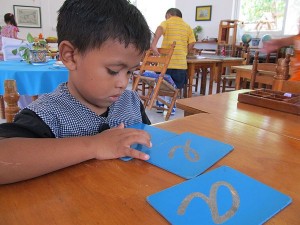 It is simple as this: a child cannot become autonomous unless we support that “secret” process. That is, that which occurs apart from us. And that requires letting go.
It is simple as this: a child cannot become autonomous unless we support that “secret” process. That is, that which occurs apart from us. And that requires letting go.
It happens at our school every day. The farewells at the classroom door take form in hundreds of ways. Sometimes there is much grace and ease, and sometimes less. Either way, there is poignancy and drama. I would venture to guess that once we have said goodbye, if given the chance to return unnoticed through the back door and watch our children in the classroom, most of us would jump at the chance. Because we like to see. We love knowing how they’re doing, what they choose, who they know, how they are. And this feeling doesn’t go away.
I had my comeuppance at a football game last fall. There in the stands, band new 400 millimeter camera lens in hand, I found myself following agile moves of our high school senior on the field. Through the mighty magnifying device I barely missed a move.
And then it came to me: echoes of the same speeches I give to parent all through orientation week at school. They will eave you. They must. And I started to laugh. For a simple as is the urge to take one more peek at the classroom door, observing our children as they grow becomes increasingly complex. The metaphor is perfect: What do you do as they grow further away? You get a bigger lens.
Or maybe not! And therein lies the art of parenting. To know when to pick up the lens and when to let the moment pass. When to ask direct, coddle or intervene and when to remain silent, or simply to make way. To allow our children that grace of their best and most authentic development, we must allow them room to grow; apart from us.
Recently I heard a most disturbing story of adolescent gang violence on the radio.
“What could they have been thinking?” asked one adult in response. Or were they thinking? Our news is filled with the perils of our times: adolescents facing increasing exposure to violence and a sea of worldly temptations with short-lived rewards. We pray for wisdom to guide them and are well-aware of our limitations.
It comes down to this: it’s up to them. Just as in a Montessori environment, ultimate safety and responsibility is achieved not by offering non breakable dishware and dulled utensils for the preparation of food. Children are safer and more competent when they learn the truth about carrying a pitcher with care because it can be a thing of danger. How very receptive our children are rising to the occasion. And how very important is the role of the adult. It is a fine-tuned dance, Montessori’s call to “follow the child”. As our children respond to their own inner directives, we respond to our children by keeping our promise to meet them on the high road. “Indefatigably”, as E.M. standing says, irresistibly joyfully, the child is working to create the adult.”
A story is told about a young child and her dad. In later stages of toilet training, the father had very simply ritualized a gesture of privacy in the bathroom. After the child settled into the task, the father would leave the room for a minute or two and wait outside the door. Once, after gently closing the door, he unwittingly flipped down the light switch in the hallway, leaving the bathroom in complete darkness. Waiting outside, he realized what he had done when he heard the gentle voice of this child from the inside: “Where did I go?” she said.
Not “Hey! Who turned out the lights?” but in the child’s inimitable honesty, she looked first to herself, to see if she was still there.
We might shift the story only slightly, imagine it as symbolic, and remember the call to core Montessori theory. Dr. Montessori teaches us that the greatest task in the first six years of life is the construction of the self; self-construction. Not you, as I need you to be, but you at your best. This is why the lessons, presentations, and work in the early Montessori school years are geared to individual children, one-to-one. Montessori teaches us to honor the sacred task of each single child’s developing character and self-awareness.
One afternoon, two of the elementary students invited me to come quickly to the classroom to witness a discovery they had made. Their enthusiastic reverie began before we crossed the threshold of the classroom door: “First we were working with the cubing material, and we noticed how the cube of the three reminded us of the pink tower we used to use in primary. We decided to go borrow a pink tower from one of the primary classes and bring it back here. We stacked the pink tower next to the cubing material and found it was identical… all except for the ten cubes which raised it too high. We removed the ten cubes and then realized that they are identical without it. Then we realized that it’s because you can’t cube double digits. So of course that’s why the ten cube didn’t fit!”
This story is an everyday example of Montessori education at work. The symbolic process and the practical process are interdependent aspects of education for life. Having a concept in your head is one thing. To imagine it, then enact it, test and declare it, allows even greater authority once something is learned. What is learned this way becomes personal property in a most personal way. The Montessori environment exists for no higher purpose than such discovery. As these students made their discovery, they came full circle. Reaching the end of their Montessori material, they found themselves returning to the beginning to validate the whole of their finding.
Our days are not lived in isolation. Not only in education, but in relationship, in family and in the lives we intend to share together. As long as we are true to the goals of our highest purpose, we will continually discover how one piece fits with another, and how the beginning and then end have everything to do with each other.
Recently when we sent our son back to college by train, I had the idea of putting a penny on the track. After those reluctant farewells and that last sweet hug, we waved until he was out of sight. Once the train had passed, the penny had flown off the track and laid there in the darkness only a few feet away. It had flattened into a shining paper-thin slip of copper. As I rubbed my thumb over the surface, I discovered only one remnant of its original penny-state. Most of the word Liberty still remained intact across one edge of the coin.
Sometimes the messages we receive are subtle. Sometimes they are inescapable. And this one I needed to hear again: Saying good-by is saying good-bye, and that means letting go and meaning it. Physical and psychic Liberty.
Montessori calls us to this most difficult task as parents when she mandates us to “Follow the Child”. Follow does not mean to hover over, but rather something much more difficult to realize. When we truly honor our children’s growth, we also honor the incremental stages of releasing them as separate and honorable –and eventually, wholly apart from us. It’s a lifetime process, and it begins with the mystery of life itself. Just as the in uterus process occurs where we cannot wee it, the psychic growth of human life occasionally has its comparable autonomy. When we refrain from inquiring after our child’s every thought, and give them space to find their way, check-in with themselves, a chance to report the news of the day without having known it first ourselves, we take the early steps. As our urges would have us ask and ask, our slip back around the corner to peek into the classroom and try to catch them unaware, we are reminded, as I was when I nearly tried to lick up his tracks, that liberty truly gained does not have strings. To follow the child includes their incremental release and the courage to allow our children to try this world out, inch by inch, apart from us.
Montessori Children
Montessori observed the phenomena of “normalization,” that condition during which children showed their true nature, peacefulness, calm, and an industriousness that has come to be surprising in young children. We seek normalization in our classrooms. We discuss children as not yet normalized. We admire the normalized child who was such a handful before.
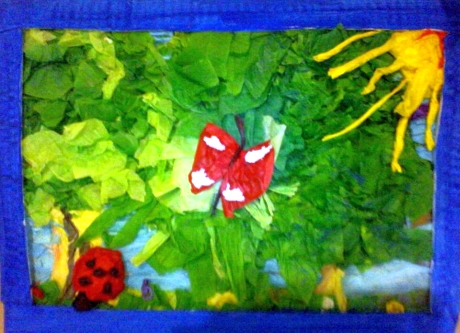 By focusing, though, on the goal of the normalized child, we distance ourselves from the children at hand. Each child in our classrooms comes to us perfect, and it is our obligation to treat the child with the same love and reverence when his or her behavior is challenging as we do this idealized normalized child. Consider the normalized child who suddenly suffers a child more grace, because we have seen this child as normalized, than we do the child who has yet to overcome the simpler, hidden stressed of children’s lives. We are more forgiving. We are more compassionate. We have loved the normalized child entirely, and because we have loved her, we hurt with her and for her.
By focusing, though, on the goal of the normalized child, we distance ourselves from the children at hand. Each child in our classrooms comes to us perfect, and it is our obligation to treat the child with the same love and reverence when his or her behavior is challenging as we do this idealized normalized child. Consider the normalized child who suddenly suffers a child more grace, because we have seen this child as normalized, than we do the child who has yet to overcome the simpler, hidden stressed of children’s lives. We are more forgiving. We are more compassionate. We have loved the normalized child entirely, and because we have loved her, we hurt with her and for her.
Each child deserves that same forgiveness, that same compassion; for the work each child accomplishes on the path to adulthood is exactly the work that child is to do. Montessori warned us that we could not do the work of becoming on the child’s behalf. We see children who, it seems, have everything, and it is difficult not to hold their life’s status against them when their behavior challenges us. We become angry with their parents for spoiling them or for not doing just as we have directed. We are frustrated that they don’t respond as quickly, that they are not served by the materials we have chosen for them. And in our judgment, we separate ourselves even further. It is only through empathy that we can understand the child’s life. It is only through compassion that we can serve her. We must look at the child who is standing in front of us (or lying on the ground screaming in front of us!) and see the child who is yet to come. We revere the child for her potential. We respect her for her promise. While continue to do this work, and gives foundation to our accomplishment as teachers, sometimes the most important work we do is for the child we never see change.
If we have neither sufficient experience nor love to enable us to distinguish the fine and delicate expressions of the child’s life, if we do not know how to respect them, then we perceive them only when they are manifested violently. Maria Montessori
The pic shows a work done by a 5 years old child during his English lesson.
Children are not complicated…
 September 21st we celebeated the International Day of Peace. It was very joyfull to listen to the kids voices when they read theis messages of peace and then sent them to the blue sky. Children are always looking for happiness, that is their natural way of living in harmony and peace. It is us, the adults who complicate the situations.
September 21st we celebeated the International Day of Peace. It was very joyfull to listen to the kids voices when they read theis messages of peace and then sent them to the blue sky. Children are always looking for happiness, that is their natural way of living in harmony and peace. It is us, the adults who complicate the situations.
In this post we want to share a text written by Catherine McTamaney. A beautiful reflexion to see that everytime is a good time to take good opportunities.
How complicated are the children. Really? We can track their development, predict emerging skills, judge their growth spurts, and chart their progress. Doesn’t it all look pretty much the same in the end? Children come to us, they learn with us, they move on. Three-year-olds become four-year-olds. Four-year-olds become five-year-olds. And so on. And on. And on.
 Over time, over children, we grow more comfortable in what to expect, and so can better understand the child whose development is surprising. But in that comfort, we can sometimes project on to children what we expect of their development, when we should be responding to it because we have seen it concretely in each child. Don’t the children all become wild in the spring? Isn’t December always a difficult month? Doesn’t the best work of the year happen in January and February? Perhaps, Maybe not.
Over time, over children, we grow more comfortable in what to expect, and so can better understand the child whose development is surprising. But in that comfort, we can sometimes project on to children what we expect of their development, when we should be responding to it because we have seen it concretely in each child. Don’t the children all become wild in the spring? Isn’t December always a difficult month? Doesn’t the best work of the year happen in January and February? Perhaps, Maybe not.
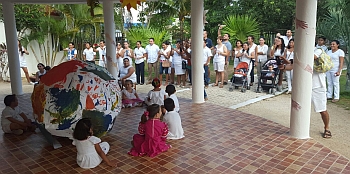 Remember the secret of childhood? What is the secret? That inner drive that push that we cannot perceive, that we can no longer understand because we are no longer children. In our loss of words, we seek other ways to demystify children. We track and predict and judge and chart. We put children’s development onto clearly defined, carefully laid-out spread-sheets for their parents to understand. We justify. Checklists are easier for teacher to complete. They are easier for parents to understand. But what about the details that don’t fit into the boxes? We overlook the unique wonderment of each child by focusing instead on the predictors that we have chosen. We come up with our list of the individual traits that we value, and we check off when the child has shown them, and so abdicate our duty to continue to try to perceive the uncountable galaxies within each child.
Remember the secret of childhood? What is the secret? That inner drive that push that we cannot perceive, that we can no longer understand because we are no longer children. In our loss of words, we seek other ways to demystify children. We track and predict and judge and chart. We put children’s development onto clearly defined, carefully laid-out spread-sheets for their parents to understand. We justify. Checklists are easier for teacher to complete. They are easier for parents to understand. But what about the details that don’t fit into the boxes? We overlook the unique wonderment of each child by focusing instead on the predictors that we have chosen. We come up with our list of the individual traits that we value, and we check off when the child has shown them, and so abdicate our duty to continue to try to perceive the uncountable galaxies within each child.
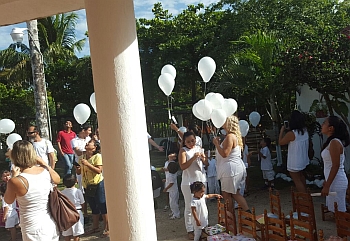 If we are unable to easily give details, if It is too difficult or time consuming to describe the unique wonderment of each child, we are not paying close enough attention. Montessori is based on the attention to each individual. Children come before our manuals. We should know, at any moment, the endless ways in which two children are different, or we are not watching carefully enough. Using a checklist for its simplicity has its merits. But don’t pretend that children are simple. Leave space for the unexpected, and know that every child is unexpected.
If we are unable to easily give details, if It is too difficult or time consuming to describe the unique wonderment of each child, we are not paying close enough attention. Montessori is based on the attention to each individual. Children come before our manuals. We should know, at any moment, the endless ways in which two children are different, or we are not watching carefully enough. Using a checklist for its simplicity has its merits. But don’t pretend that children are simple. Leave space for the unexpected, and know that every child is unexpected.
The secret of good teaching is to regard the child’s intelligence as a fertile field in which seed may be sown, to grow under the heat of flaming imagination. Maria Montessori.
Grace and courtesy: education for peace
The art of conveying the grace and courtesy is a real education for peace. It is a lifestyle, a way of being, it comes in a natural way when practiced daily as part of life itself .
In Montessori, children are in contact with a world of calm, receiving example of good manners and making
activities that transmit their love for life and respect for the environment around them. It is an Education for Life, children grow generating positive energy that is regenerated when they get in touch with other children.
Grace and courtesy are seeds that germinate in school fed by the environment in which they grow. Grace and courtesy are, without a doubt, seeds sown at home that will give fruit if they are maintained with love.
A Mayan Tradition: Hanal Pixan at Otoch Paal
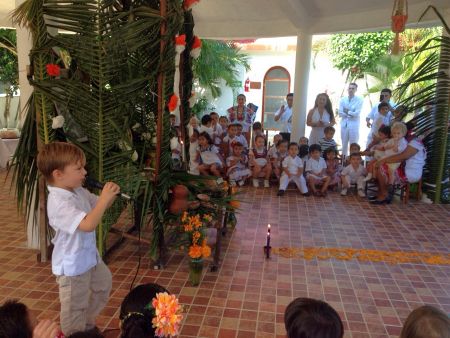 Mayan people remember their dead in a unique and original way. Each year, thousands of homes fill up with the scent of the “Cempasuchil” flower (Mexican
Mayan people remember their dead in a unique and original way. Each year, thousands of homes fill up with the scent of the “Cempasuchil” flower (Mexican 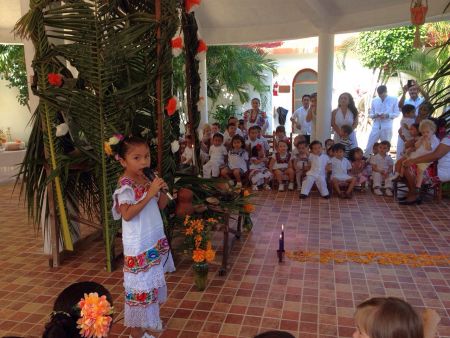 marigold), which they use to adorn the altars they lay out for their loved ones who have passed away. Mexicans think of death in a distinct way. They fear it and respect it, but they’re also able to laugh at it.
marigold), which they use to adorn the altars they lay out for their loved ones who have passed away. Mexicans think of death in a distinct way. They fear it and respect it, but they’re also able to laugh at it.
This view of death has prevailed for over 500 years; it started long before the Spanish brought Christianity to Mesoamerica. Both the Aztecs and the Mayans would have many rituals to help their dead on their journey to the underworld, the mythical world of the dead. Death was viewed only as a transitional stage in their universe.
Although the Spanish tried to convert the natives to Catholicism and institutionalized observance of the Day of the Faithful Departed, the natives found a way to continue their ancient traditions in disguise, and they transformed this Catholic tradition into what is known today as the celebration of the Day of the Dead. Meanwhile in the Yucatan Peninsula, the Mayans also honored their dead in slightly different celebration they called Hanal Pixan.
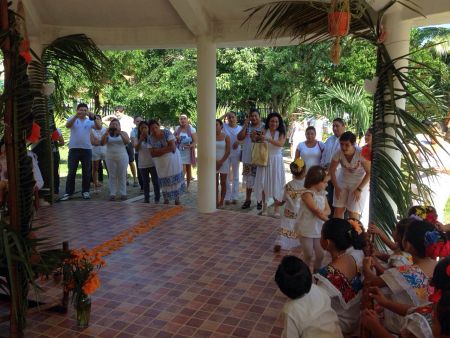 Hanal Pixan translates as “food for the souls”, and it does not only take place on one day, but it’s a celebration that lasts over a week. Most homes are adorned with an altar covered in offerings to welcome the souls of their dead relatives who come to see the living. It is believed that the dead come back to their home to be with their loved ones, to eat their favorite foods and to rest from the long journey, and eventually go back to their mythical resting place again.
Hanal Pixan translates as “food for the souls”, and it does not only take place on one day, but it’s a celebration that lasts over a week. Most homes are adorned with an altar covered in offerings to welcome the souls of their dead relatives who come to see the living. It is believed that the dead come back to their home to be with their loved ones, to eat their favorite foods and to rest from the long journey, and eventually go back to their mythical resting place again.
Every year, schools hold contests for the best altars. Students often learn about this important tradition by making their own altars at school to participate in the contest. It’s a good way to keep the tradition alive and teach the younger generations about it.
In the countryside, altars are set up the front porch or patio of many homes, or just about anywhere they can fit a table. They often add two more levels to form a three-story altar, covering it with a white table cloth, many times made especially for this occasion. The altar includes crosses, flowers, fruits, palm leaves, gourds with hard liquor, photos and memorabilia from the departed, among other elements.
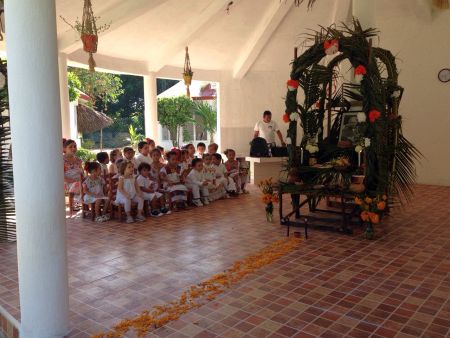 During the week of Hanal Pixan, there’s a day dedicated to honor the souls of children. Their altars include traditional candy, toys and colorful flowers that are believed to catch the children’s attention.
During the week of Hanal Pixan, there’s a day dedicated to honor the souls of children. Their altars include traditional candy, toys and colorful flowers that are believed to catch the children’s attention.
The offerings for adult souls are more serious, and they include different traditional dishes, such as pib or mucbilpollo (a large tamal cooked in a pit), chachac wajes (a tamal in red sauce), chacbinal (boiled corn), salbutes, atole (a hot, thick cornmeal drink), and other drinks that the departed used to like.
On the last day of this eight-day celebration, called Biix in Mayan language, they hold a mass in honor of the dead to wish them a safe trip back to their mythological resting place. They also light a path with candles on the front porch or patio to guide them on their way.
It’s impressive that these ancient traditions have managed to prevail to this day, in spite of world globalization and influences from foreign customs and celebrations, such as Halloween. Let’s not forget that the importance of Hanal Pixan and the Day of the Dead is to remember those who have passed away.
If you happen to come to the Yucatan during October or the first week of November, remember to ask people where you can see one of these altars so you can experience this special tradition first hand.
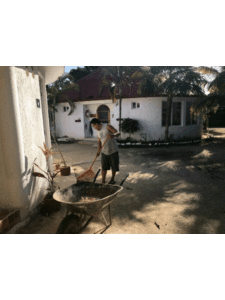




Comentarios recientes